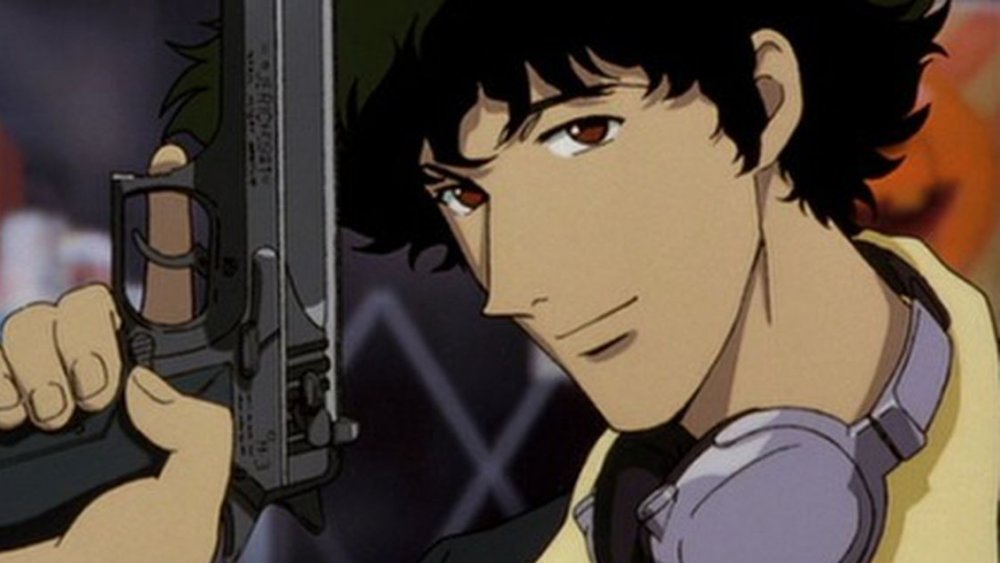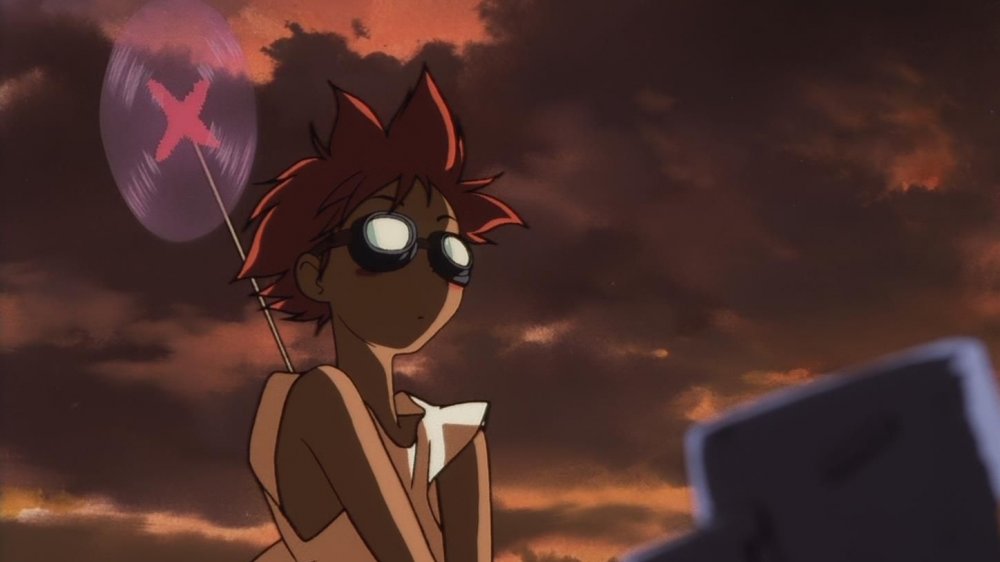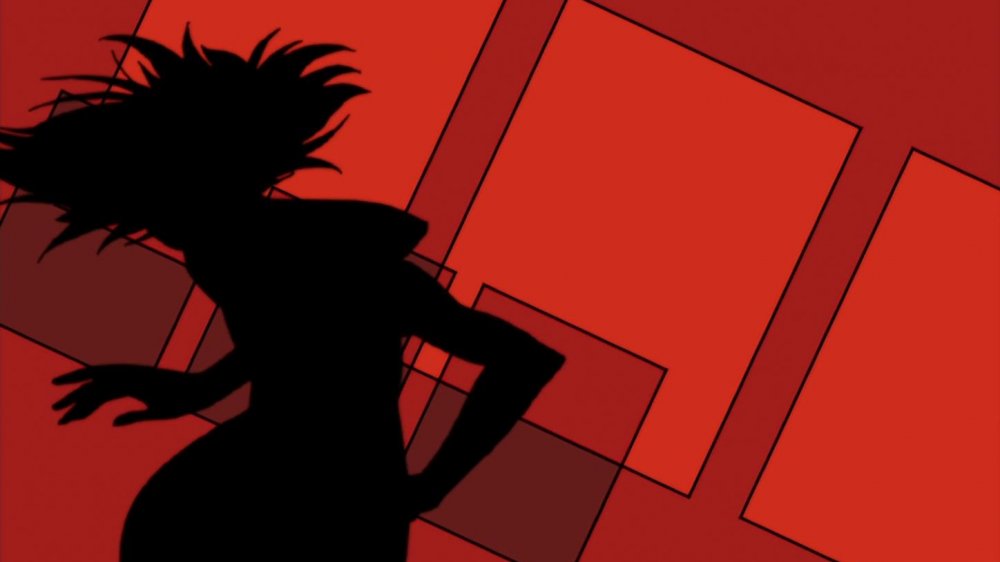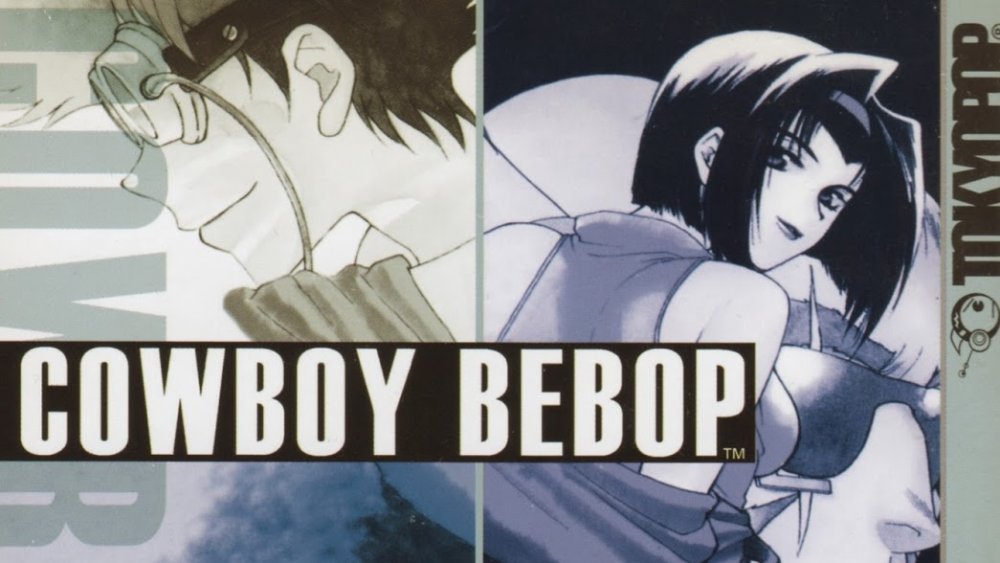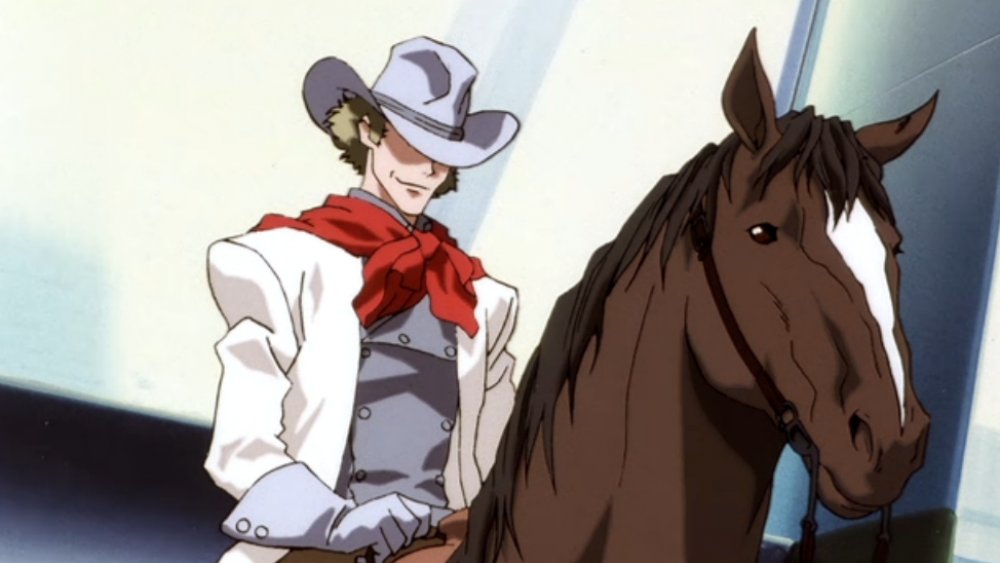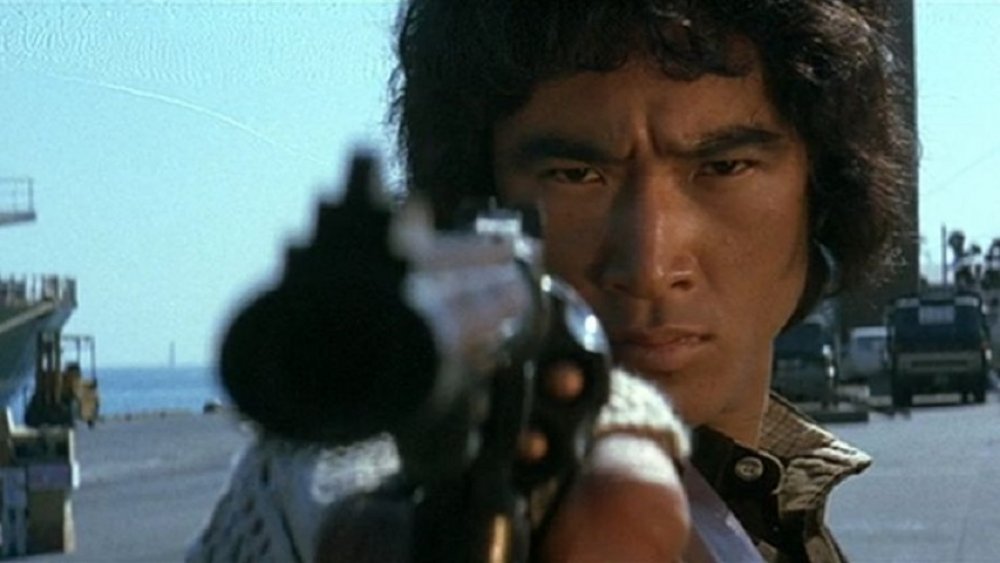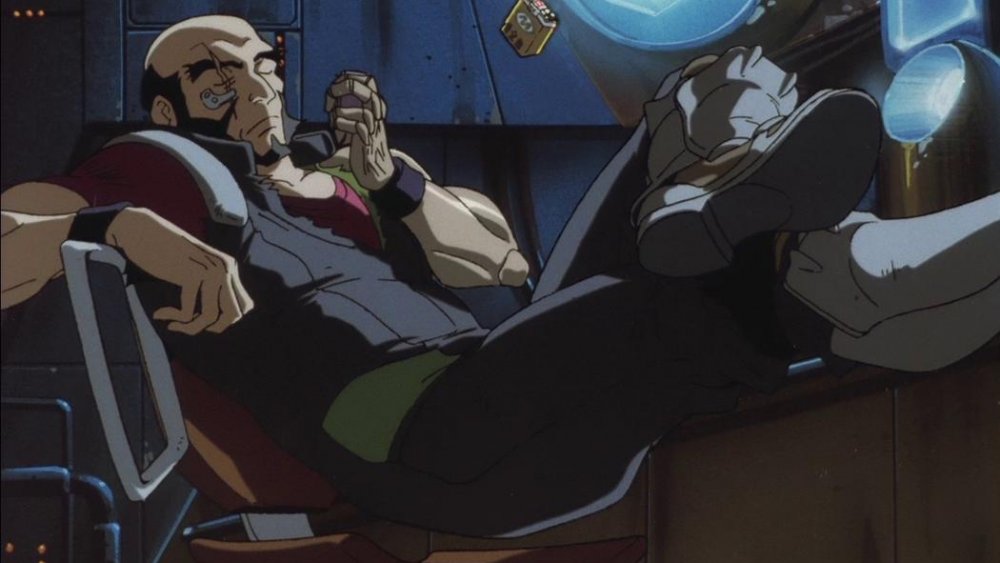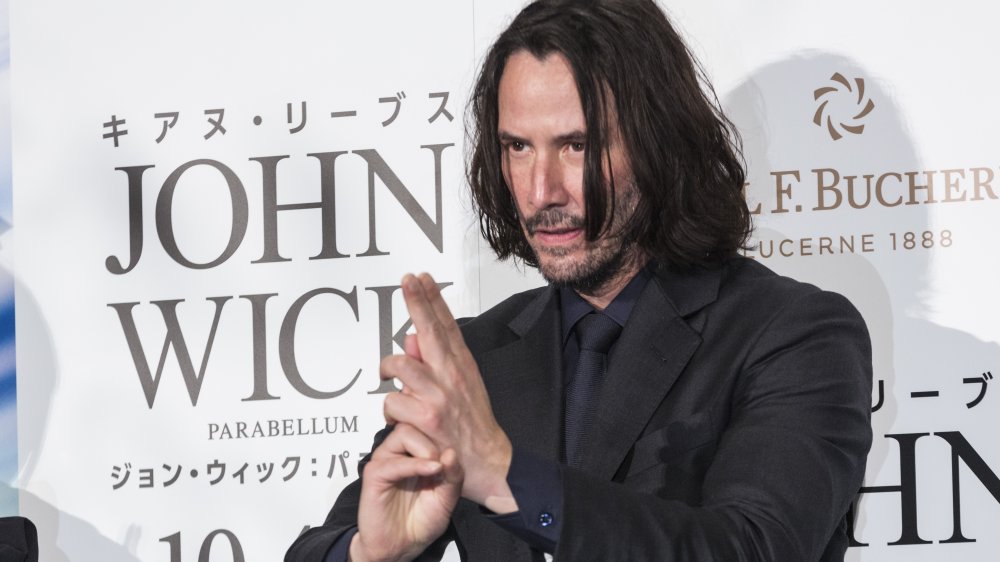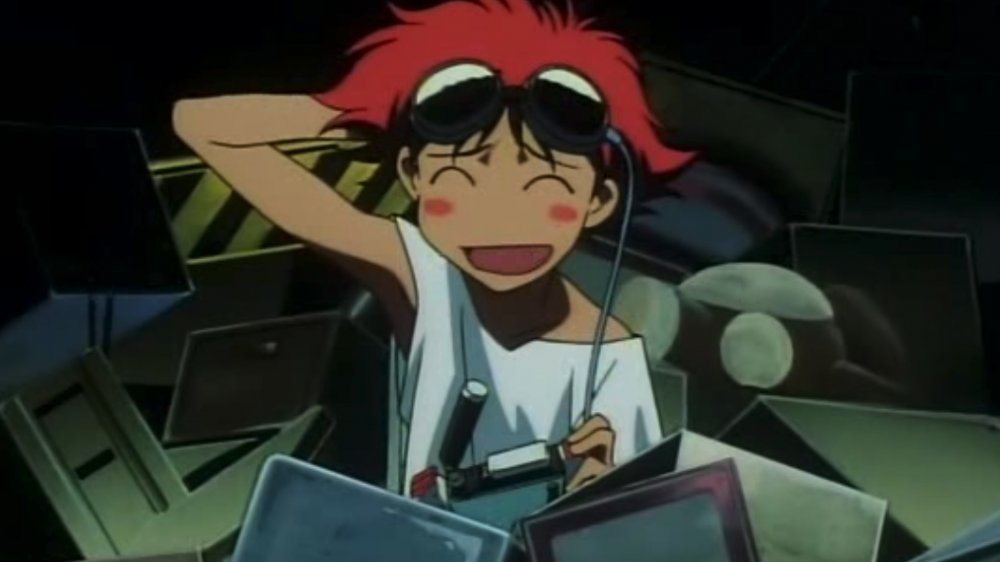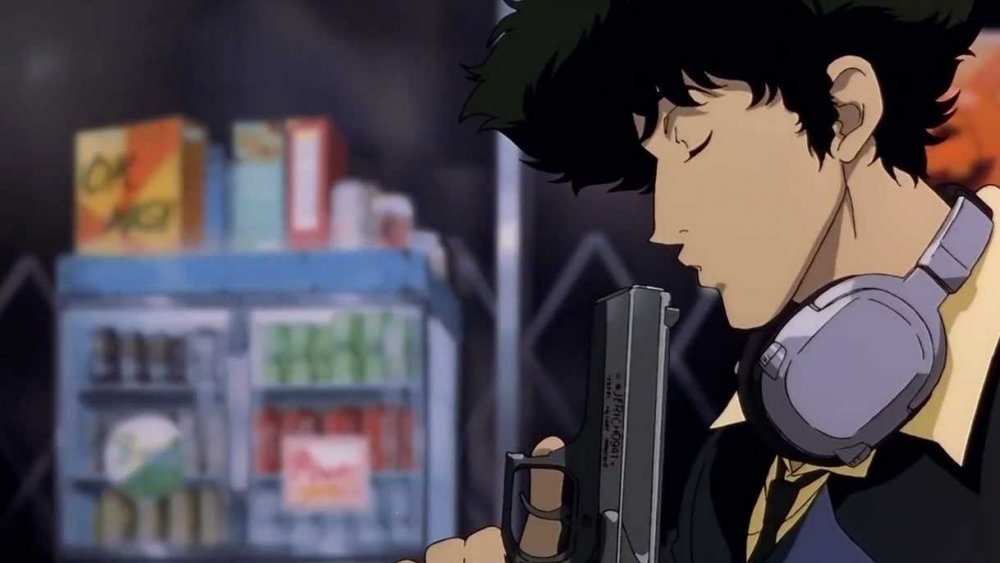The Untold Truth Of Cowboy Bebop
If you were a preteen with cable in the early 2000s, there's a good chance you either tried to convince your parents to let you stay up to watch Cartoon Network's late night Adult Swim block, or you learned how to record using a VCR and a blank VHS tape. Late night was the time for adult cartoons, but more to the point, it was the time for adult anime, and there were some seriously good offerings for those who'd graduated from Pokemon and wanted something with a little more intrigue.
And what could make a 13-year-old feel cooler than watching Cowboy Bebop, that effortlessly hip space Western/moody noir/martial arts series with the stunning, no-holds-barred soundtrack? Now over two decades old, Cowboy Bebop remains one of the most well-known, well-regarded, and beloved series among anime fans and beyond, using its wide-reaching influences to dazzle a diverse audience. And just like the story of Bebop itself, there's a lot going on under the surface of this fan favorite, keeping audiences coming back time and again. So without further ado, here's the untold truth of Cowboy Bebop. Let's jam.
It was made for merch
It seems as though a series like Cowboy Bebop would be the product of great intentionality, something that series creator and director Shinichiro Watanabe had been plotting out for ages. But the truth of the matter is that he was actually tasked with creating a show to sell space-themed merch for Bandai Toys. Clearly, what Watanabe and his crew came up with didn't quite fit the bill, being as it hardly appeals to young kids intent on spending their allowance on plastic rocket ships. To be fair, the ships in the show are definitely cool and worthy of the toy treatment, but the show's focus on the laconic Spike Spiegel and his bounty hunting exploits in a dystopian vision of space hardly make for all-ages viewing material. As a result, Watanabe's space vision was laid to rest for a while before eventually being picked up by Bandai Toys' sister company, Bandai Visual, who decided it might have a different market appeal.
Cowboy Bebop is a musical masterpiece
From the very first millisecond of Cowboy Bebop's opening theme, it's clear that the music in the series is something truly special. The score — composed by Yoko Kanno, along with performances by the Seatbelts, the band she formed specifically to work on this series — is a genre extravaganza. It ranges from the obvious jazz (of all subgenres) to opera, metal, folk, and country, stopping everywhere in between and shining with outstanding examples of each genre.
Director Shinichiro Watanabe allegedly didn't provide Kanno with much instruction, instead allowing her vision to dictate some of the characters and action in the show itself. Each character has their own unique sound for the songs that represent them, which is evident if you listen closely. (Well, you don't need to listen too closely to Ed's songs, as they're the easiest to discern, with their upbeat, bouncy rhythms.) And apparently Kanno has a kind of synesthesia, where she associates sound with color, though she wants to keep the exact nature of this trait a trade secret.
By the time she was done composing, Kanno had produced far more songs than were asked for, resulting in a truly enormous series of soundtracks. And that's a boon to anyone who wants to keep the Bebop feeling alive long after they've finished watching the show.
Bebop manga
Usually, an anime series is created as an adaptation of a successful manga series. On rare occasions, however, a totally original anime series generates enough critical success to spawn a merchandising frenzy, which will include comic book adaptations. That's no different in Japan as it is here in the United States. And while Cowboy Bebop was maybe never destined to sell spaceship toys to small children, it was appealing enough to its audience to garner a fair amount of consumer products, including two manga series: Cowboy Bebop and Shooting Star Bebop. Because the anime was a huge hit stateside as well, North American licensor and publisher Tokyopop brought an English-language adaptation of both these titles to the West. Unfortunately, neither of them could quite hold the unique charm of the original anime. After all, how many people were watching at least partially for Kanno's incredible score? The manga are now long out of print in English, but they're a fascinating relic of early-2000s anime marketing that are sure to appeal to any mega-fan.
Inspirations from cinema and anime
For fans in the West, especially those who love cinema, it's surely obvious that director Shinichiro Watanabe is well-versed in film. After all, Spike's history, often shown in black-and-white flashback sequences, is clearly influenced by film noir. The whole concept of bounty hunting cowboys is Clint Eastwood Westerns all the way, and there's even an episode, "Cowboy Funk," that plays humorously with spaghetti western tropes.
In a somewhat controversial move, the episode "Mushroom Samba" plays with blaxploitation, even explicitly referencing the 1971 film Shaft. What might be less obvious, unless you were watching Cowboy Bebop on that late-night Adult Swim block alongside the other anime on there, is the influence of Kazuhiko Kato's Lupin III. The hero of Lupin III is a wacky, savvy, gentleman super-thief who's depicted as over-sexed, over-intelligent, and always up for an absurd challenge. Though Spike's character is toned down a bit from this, his lanky frame, exaggerated body language, and overall penchant for getting into trouble definitely seem in keeping with Lupin — not to mention his very '70s-style suit and hair!
The actors who inspired the bounty hunter
One of the most iconic anime characters of all time, Spike Spiegel seems to be based on a couple of real-life actors. The first is Japanese actor Yusaku Matsuda (pictured above), especially in regards to the TV series Tantei Monogatari (aka Detective Story). Matsuda is playing a detective in this show, but his general look, including a shaggy haircut and a snappy suit, is very much in keeping with Spike's, as is his general "cool" factor.
The other actor who can't be overlooked as major Spike inspiration is one much more familiar to American audiences: Bruce Lee. Though Spike does use a gun pretty frequently throughout the series, he also favors his own brand of martial arts, which he attempts to teach inept mob member Roco Bonnaro in the episode "Waltz for Venus." This personalized practice was heavily influenced by Lee's Jeet Kune Do, which isn't based on a fixed series of movements like many other martial arts, but rather adapts to the situation. In other words, "You have to be like water."
Cowboy Bebop is loaded with musical references
Cowboy Bebop isn't shy about dropping references at every turn, and its musical involvement doesn't end with its phenomenal soundtrack. Most of the episode titles reference a type of music ("Heavy Metal Queen," "Waltz for Venus," "Jupiter Jazz") or a specific song title ("Honky Tonk Women," "Sympathy for the Devil," "Bohemian Rhapsody," "My Funny Valentine"). Then, of course, there's Jet's preoccupation with jazz music, hence his naming his ship the Bebop. Jet even regales Spike with a dream he had about jazz composer Charlie Parker, who told Jet, "If you want to receive, you have to give."
Then there's the main song's opening theme — that jazzy, snazzy, James Bond-esque anthem — which is a reference to the blues album The Real Folk Blues by Howlin' Wolf. And those three old guys who always pop up in the background, bickering and reminiscing? Their names are Antonio, Carlos, and Jobim, which is a clear reference to Brazilian composer and musician Antonio Carlos Jobim, who's largely credited as one of the biggest influences of bossa nova, which itself is a blending of samba and jazz.
And who can forget that very last title card in the series' very last episode? It's the one that reads "you're gonna carry that weight," and it's perhaps the most easily recognized reference of all, hailing from the Beatles themselves. It's clear that the team working on Cowboy Bebop truly loved everything about music, its history, and its influence, and that clear dedication means that audiences get to pick up on something new with each viewing.
The show has some famous fans
Cowboy Bebop is one of those series where just about everyone, regardless of their interest in other anime, knows about it and enjoys it. This sentiment isn't restricted to just the common folks who stumbled upon it while browsing channels one night. A few very famous individuals have sung the series' praises. For example, there's Keanu Reeves, who really wanted to play Spike in a movie version that never got off the ground. And during a Reddit "Ask Me Anything" session, the late Robin Williams, when asked about what kind of anime he liked, mentioned Cowboy Bebop, as well.
But it's not just movie stars with backgrounds in action, comedy, and drama (all of which are very prevalent in the anime) who can't get enough of Bebop. Renowned science fiction author Orson Scott Card, best known for his Ender's Game books, has described the series as "brilliant," particularly mentioning the series' "strong relationship-based storytelling" and its exceptional visuals. As a sci-fi author, surely Card can appreciate a good space opera when he sees it!
The Cowboy Bebop video games
Much like space toys, Bebop doesn't seem like the ideal vehicle for inspiring video games. That didn't stop Bandai, however. The first game, produced in 1998 for the PlayStation, was simply titled Cowboy Bebop. In this game, players control Spike's one-man ship, Swordfish II, and chase down bounty heads. In 2005, Cowboy Bebop: Tsuioku no Serenade was released for the PlayStation 2. This was a more action-based game, where players could choose Spike, Jet, or Faye as their player character and interact with enemies in both hand-to-hand and gun-slinging fights.
Neither of these games ever made it out of Japan, but 2019 saw the release of the tactical role-playing game Super Robot Wars T throughout all of Asia. This game franchise takes spaceships from multiple series, and in this installment, they chose to include Bebop in their roster. This comes as a bit of a surprise, considering the series' age and how it differs from series like Gundam, also represented in the game. But then, they chose to include Magic Knight Rayearth this time around, as well, keeping the ships and the characters who pilot them diverse.
Cowboy Bebop: The Movie
Once upon a time, there were rumors going around that Hollywood would make a live-action adaptation of Cowboy Bebop starring Keanu Reeves. Of course, that never came to be, which is probably for the best because Hollywood is pretty bad at adapting anime. But while we may never get a live-action, feature-length movie, we were blessed with the exceptional animated film, originally titled Cowboy Bebop: Knockin' On Heaven's Door, named after the Bob Dylan song.
Shinichiro Watanabe, obviously quite the film buff, approached every episode of the original series as though it were its own mini-film. But once he had free reign (and a larger budget) to go for the real deal, the story really got to shine. Set at some point before the last fateful episodes of the series, the film explores a bounty head, Vincent Volaju, who's threatening Mars with a terrorist attack. With the time allowed in film, the writers were able to explore each character's interior thoughts and feelings more thoroughly, especially those of Spike, who often comes across as flippant or airheaded in the series.
And a higher budget and more production time allowed the already impressive animation of the series to be improved upon even more, such that the film's gorgeous color and fluidity can't be ignored. Shots were composed more carefully, as well, more similar to how they might work in live-action as opposed to animation. Plus, composer Yoko Kanno returned to provide her signature sound for the music, tying the film together beautifully. It's unlikely that we'll ever see a true sequel to Cowboy Bebop — after all, why spoil a good thing? — but it's always gratifying to have supplemental materials like the film to keep our toes tapping and to satisfy our inner cinema nerd.
